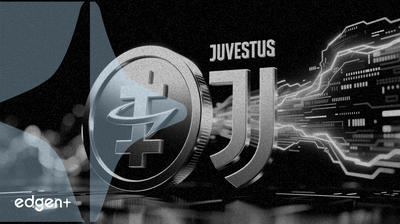Quay lại


## Tóm tắt điều hành Tether, nhà điều hành stablecoin **USDT**, đã đệ trình đề xuất toàn tiền mặt để mua lại 65,4% cổ phần kiểm soát của **Exor** trong câu lạc bộ bóng đá Ý **Juventus FC**. Đề xuất này đi kèm với cam kết bơm thêm 1 tỷ USD vào câu lạc bộ sau khi hoàn tất. Động thái này thể hiện một nỗ lực chiến lược đáng kể của một thực thể crypto-native lớn vào thế giới thể thao truyền thống, nhằm tận dụng nguồn dự trữ vốn đáng kể của mình để mua lại một thương hiệu được công nhận toàn cầu và ổn định nền tảng tài chính của nó. ## Chi tiết sự kiện Đề xuất phác thảo một chiến lược tài chính hai mũi nhọn. Thứ nhất, việc mua lại toàn bộ cổ phần đa số của **Exor** bằng tiền mặt sẽ chuyển quyền kiểm soát câu lạc bộ sang **Tether**. Thứ hai, khoản bổ sung vốn 1 tỷ USD sau đó được dành để xóa các khoản nợ hiện có và đầu tư vào năng lực hoạt động và cạnh tranh của câu lạc bộ. Giao dịch này, nếu thành công, sẽ đánh dấu một trong những giao điểm nổi bật nhất giữa ngành công nghiệp tài sản kỹ thuật số và các tổ chức truyền thống, có khả năng hủy niêm yết Juventus và đưa nó vào quyền sở hữu tư nhân dưới sự điều hành của gã khổng lồ tiền điện tử. ## Cơ chế tài chính và bối cảnh chiến lược Các câu lạc bộ bóng đá châu Âu thường được đặc trưng bởi các khoản nợ đáng kể. Ví dụ, **Manchester United** (NYSE: MANU) gần đây đã báo cáo nợ ròng của mình vượt quá 1 tỷ USD sau một giao dịch mua lại có đòn bẩy. Các câu lạc bộ khác đã theo đuổi các cấu trúc tài chính phức tạp để quản lý các khoản nợ phải trả. **AC Milan** gần đây đã tìm kiếm một khoản vay tín dụng tư nhân holdco khoảng 600-700 triệu USD để tái cấp vốn cho khoản nợ do chủ sở hữu trước đó, Elliott Investment Management, nắm giữ, sử dụng các công cụ với các tùy chọn thanh toán bằng hiện vật (PIK). Trong bối cảnh này, đề xuất toàn tiền mặt của **Tether** đưa ra một cách tiếp cận khác biệt rõ rệt. Thay vì tận dụng tài sản để tài trợ cho việc mua lại của chính mình, **Tether** nhằm mục đích sử dụng vốn hiện có của mình để giảm hoàn toàn đòn bẩy cho câu lạc bộ. Chiến lược này ít giống với các giao dịch mua lại có đòn bẩy phổ biến trong thể thao mà giống hơn với một vụ mua lại chiến lược của một tập đoàn tư nhân giàu tiền mặt, chẳng hạn như vụ tiếp quản toàn tiền mặt trị giá 36 tỷ USD gần đây của **Mars, Incorporated** đối với **Kellanova**. Động thái này sẽ cung cấp cho **Juventus** một bảng cân đối kế toán sạch, một lợi thế cạnh tranh đáng kể trong một ngành công nghiệp thâm dụng vốn. ## Hàm ý thị trường rộng lớn hơn Việc mua lại thành công sẽ đóng vai trò là một sự xác nhận lớn cho **Tether** và hệ sinh thái tiền điện tử rộng lớn hơn. Đối với **Tether**, nó đại diện cho một sự đa dạng hóa chiến lược, triển khai các nguồn dự trữ khổng lồ của mình vào một tài sản phi kỹ thuật số, có hồ sơ cao. Điều này có thể nâng cao tính hợp pháp của nó và thể hiện một tầm nhìn dài hạn vượt ra ngoài giới hạn của thị trường tiền điện tử. Thỏa thuận này cũng có thể thiết lập một chiến lược mới cho các công ty crypto-native, chứng minh rằng lợi nhuận được tạo ra trong không gian tài sản kỹ thuật số có thể được triển khai hiệu quả để mua lại và hồi sinh các thương hiệu lớn trong thế giới vật chất. Một động thái như vậy báo hiệu sự trưởng thành của ngành từ giao dịch đầu cơ sang tài chính doanh nghiệp chiến lược, có khả năng khuyến khích các công ty tiền điện tử khác theo đuổi các vụ mua lại tương tự đối với các tài sản truyền thống trong thể thao, truyền thông và các lĩnh vực khác. ## Bình luận của chuyên gia và tiền lệ Các nhà quan sát thị trường lưu ý rằng việc mua lại được đề xuất sẽ phải đối mặt với sự giám sát chặt chẽ của quy định, tương tự như bất kỳ giao dịch M&A xuyên biên giới lớn nào. Việc phê duyệt vô điều kiện thỏa thuận **Mars-Kellanova** của 28 cơ quan quản lý trên toàn thế giới cung cấp một tiền lệ gần đây về sự phức tạp liên quan. Các cơ quan quản lý có thể sẽ tập trung vào nguồn vốn và sự ổn định dài hạn của thực thể mua lại. Mặc dù thỏa thuận này là bất thường, nhưng có sự thèm muốn rõ ràng của nhà đầu tư đối với các dự án có hồ sơ cao, mang tính chuyển đổi, như đã thấy trong sự kỳ vọng của thị trường đối với một đợt IPO tiềm năng của **SpaceX**. Các nhà phân tích gợi ý rằng **Tether** đang cung cấp "phần thịt"—một khoản bơm tiền mặt đáng kể—cho "phần hấp dẫn" của một thương hiệu bóng đá nổi tiếng toàn cầu. Sự thành công của đề xuất này không chỉ thay đổi bối cảnh tài chính của bóng đá châu Âu mà còn định nghĩa lại ranh giới giữa các nền kinh tế kỹ thuật số và truyền thống.

## Tóm tắt điều hành Ripple đang mở rộng một cách chiến lược tiện ích của tài sản kỹ thuật số gốc của mình, **XRP**, bằng cách đưa nó lên các chuỗi khối **Ethereum** và **Solana**. Sáng kiến này được thiết kế để tích hợp **XRP** vào hệ sinh thái Tài chính phi tập trung (DeFi) rộng lớn hơn, vượt ra ngoài trường hợp sử dụng truyền thống của nó trong các khoản thanh toán xuyên biên giới. Việc mở rộng tận dụng công nghệ cầu nối để tạo ra các phiên bản **XRP** được gói, cho phép nó tương tác với các hợp đồng thông minh và ứng dụng trên các nền tảng DeFi hàng đầu này. ## Chi tiết sự kiện Việc ra mắt **XRP** trên **Ethereum** và **Solana** được tạo điều kiện thông qua các cầu nối xuyên chuỗi, với **Hex Trust** và **LayerZero** được xác định là các đối tác công nghệ chủ chốt. Cơ chế này liên quan đến việc khóa **XRP** gốc trên sổ cái của chính nó và phát hành một token **XRP** "được gói" (wXRP) tương đương trên chuỗi khối mục tiêu. Token được gói này được thế chấp hoàn toàn bằng tài sản gốc, đảm bảo tính ngang giá về giá. Cách tiếp cận kỹ thuật này cho phép **XRP** có được các chức năng của một token ERC-20 trên **Ethereum** hoặc một token SPL trên **Solana**. Kết quả là, những người nắm giữ có thể sử dụng **XRP** của họ trong một loạt các ứng dụng DeFi rộng rãi, bao gồm các sàn giao dịch phi tập trung (DEX) như Uniswap hoặc Serum, các giao thức cho vay như Aave và Compound, và các nền tảng canh tác lợi nhuận khác nhau có nguồn gốc từ các hệ sinh thái này. ## Ảnh hưởng thị trường Việc mở rộng này có tiềm năng tăng đáng kể tính thanh khoản và khối lượng giao dịch của **XRP** bằng cách khai thác các nhóm thanh khoản sâu của thị trường DeFi **Ethereum** và **Solana**. Đối với các nhà giao dịch và nhà phát triển trên các nền tảng này, nó giới thiệu một tài sản mới, có tính thanh khoản cao cho các cặp giao dịch, thế chấp và các chiến lược tài chính khác. Tuy nhiên, động thái này cũng tạo ra sự cạnh tranh cho các tài sản hiện có trong các hệ sinh thái này. Sự thành công của **XRP** được gói sẽ phụ thuộc vào tỷ lệ chấp nhận của các giao thức DeFi và sự sẵn lòng của người dùng để bắc cầu tài sản của họ. Hàm ý chính là sự chuyển đổi của **XRP** từ một tài sản tập trung vào thanh toán thành một công cụ linh hoạt hơn cho các dịch vụ tài chính phi tập trung, có khả năng tăng tiện ích và nhu cầu tổng thể của nó. ## Bình luận chuyên gia Sự chuyển hướng chiến lược sang tiện ích rộng lớn hơn phù hợp với những thành tựu quy định gần đây của Ripple. Sau khi Văn phòng Kiểm soát Tiền tệ (OCC) phê duyệt có điều kiện giấy phép ngân hàng ủy thác quốc gia, CEO Ripple **Brad Garlinghouse** đã nhấn mạnh trọng tâm của công ty vào việc tuân thủ và đổi mới. Trong một tuyên bố liên quan đến quyết định của OCC, ông lưu ý rằng đó là một "bước tiến lớn" cho ngành, nhấn mạnh cam kết hoạt động dưới sự giám sát của liên bang. Các nhà phân tích thị trường đã xem xét những phát triển song song này một cách thuận lợi. Một chuyên gia, được biết đến với tên 'Steph is Crypto', đã mô tả việc phê duyệt giấy phép ngân hàng sắp tới là một chất xúc tác "tăng giá" cho **XRP**, một tình cảm được lặp lại bởi những người khác trong cộng đồng tài chính, những người coi sự rõ ràng về quy định là tiền đề cho việc chấp nhận của các tổ chức. ## Bối cảnh rộng hơn Chiến lược đa chuỗi của Ripple và việc theo đuổi giấy phép ngân hàng ủy thác quốc gia là những thành phần liên kết của một mục tiêu lớn hơn: nhúng **XRP** và các dịch vụ liên quan vào hệ thống tài chính được quy định. Bằng cách có được giấy phép liên bang, Ripple có thể cung cấp dịch vụ lưu ký và thanh toán cho tài sản kỹ thuật số và truyền thống dưới sự giám sát trực tiếp của liên bang. Tình trạng này rất quan trọng để thu hút các khách hàng tổ chức yêu cầu các đối tác được quy định. Việc phê duyệt cũng mở đường cho việc tích hợp stablecoin theo kế hoạch của Ripple, **RLUSD**, vào hệ thống ngân hàng Hoa Kỳ. Một phán quyết gần đây của OCC cho phép các ngân hàng quốc gia sử dụng tài sản kỹ thuật số để thanh toán tiếp tục củng cố vị thế này. Cách tiếp cận hai mũi nhọn này – mở rộng sang các hệ sinh thái phi tập trung đồng thời giành được chỗ đứng trong tài chính truyền thống – định vị Ripple để thu hẹp khoảng cách giữa hai bên, một mục tiêu chiến lược được chia sẻ bởi các nhà cung cấp chính khác như **Circle** và **Paxos**, những người cũng đã nhận được sự chấp thuận có điều kiện từ OCC.

## Tóm tắt điều hành Interactive Brokers đã thông báo rằng họ sẽ chấp nhận stablecoin để nạp tiền vào tài khoản nhà đầu tư cá nhân. Quyết định này đại diện cho một động thái chiến lược để duy trì tính cạnh tranh khi ngành dịch vụ tài chính ngày càng tích hợp tài sản kỹ thuật số. Tính năng này dự kiến sẽ được giới thiệu thông qua một đợt triển khai dần dần, bắt đầu với một phần khách hàng Hoa Kỳ đủ điều kiện của công ty. Sáng kiến này báo hiệu một bước tiến quan trọng trong việc thu hẹp khoảng cách giữa thị trường tài chính truyền thống và hệ sinh thái tiền kỹ thuật số. ## Chi tiết sự kiện Theo thông báo, các nhà đầu tư cá nhân tại **Interactive Brokers** sẽ có khả năng gửi stablecoin trực tiếp vào tài khoản giao dịch của họ. Sáng kiến này được thiết kế để nâng cao hiệu quả và tốc độ nạp tiền so với các phương pháp truyền thống. Công ty đã định vị động thái này như một bước đi cần thiết để duy trì vị thế cạnh tranh trong bối cảnh tài chính đang phát triển nhanh chóng, nơi tài sản kỹ thuật số ngày càng phổ biến. Giai đoạn ban đầu sẽ nhắm mục tiêu một nhóm khách hàng Hoa Kỳ được chọn, với kế hoạch mở rộng khả năng tiếp cận sau đó. ## Giải mã cơ chế tài chính Sự tích hợp này cho phép các nhà đầu tư sử dụng stablecoin được neo giá vào tiền pháp định, chẳng hạn như **USDC**, làm công cụ nạp tiền trực tiếp. Không giống như các khoản chuyển khoản ngân hàng truyền thống (ACH hoặc chuyển khoản ngân hàng), vốn phải tuân theo giờ làm việc của ngân hàng và có thể mất vài ngày làm việc để thanh toán, các giao dịch stablecoin có thể được xử lý gần như tức thì, 24/7, trên các mạng blockchain tương ứng của chúng. Cơ chế này giúp giảm thời gian thanh toán và có thể giảm chi phí giao dịch, mang lại một cách hiệu quả hơn để triển khai vốn vào thị trường chứng khoán. Bằng cách tận dụng cơ sở hạ tầng blockchain, quy trình này bỏ qua các kênh thanh toán thông thường cho phần nạp tiền của giao dịch. ## Ý nghĩa thị trường Quyết định của **Interactive Brokers** dự kiến sẽ làm tăng áp lực cạnh tranh lên các công ty môi giới lớn khác để áp dụng các khả năng tương tự. Khi các nhà đầu tư ngày càng quen với tốc độ và sự tiện lợi của các giao dịch tài sản kỹ thuật số, các công ty môi giới thiếu các kênh nạp tiền này có thể phải đối mặt với bất lợi cạnh tranh. Sự phát triển này cũng được dự đoán sẽ đẩy nhanh việc áp dụng rộng rãi stablecoin, bình thường hóa việc sử dụng chúng như một công cụ tài chính tiêu chuẩn để chuyển giao giá trị chứ không phải là tài sản tiền điện tử chỉ mang tính đầu cơ. Nó cung cấp một tiện ích quan trọng bằng cách tạo ra một kết nối linh hoạt hơn giữa nền kinh tế kỹ thuật số và các nền tảng đầu tư truyền thống. ## Bình luận của chuyên gia và bối cảnh rộng hơn Động thái này của **Interactive Brokers** phù hợp với xu hướng rộng lớn hơn của các công ty tài chính đã thành lập tích hợp công nghệ stablecoin. Chẳng hạn, **Visa** đã tiến hành tích hợp stablecoin vào mạng lưới thanh toán toàn cầu của mình. **Yanilsa Gonzalez-Ore**, phó chủ tịch cấp cao tại **Visa Direct**, lưu ý rằng công ty đang ở 'tiên phong của các khoản thanh toán thời gian thực và các công nghệ mới nổi, như AI và stablecoin.' Vào tháng 11, **Visa** đã ra mắt một chương trình thí điểm cho phép thanh toán bằng stablecoin bằng **USDC** cho những người sáng tạo và người lao động trong nền kinh tế gig, chứng minh tính khả thi của việc sử dụng tiền kỹ thuật số cho các khoản thanh toán toàn cầu nhanh hơn, hiệu quả hơn. Những hành động này của các tổ chức tài chính lớn như **Visa** mang lại độ tin cậy đáng kể cho con đường chiến lược mà **Interactive Brokers** đang theo đuổi, định hình nó như một sự thích ứng cần thiết với cơ sở hạ tầng tài chính hiện đại.